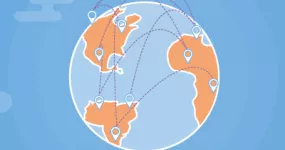Geopolitical affairs and the supply chain
Published on 23 May 2019

In the current climate of intensified international relations, there is no shortage of challenges when it comes to the supply chain. In addition to seeking out cost-saving measures, your company must find the organizational and technological growth levers it needs to attract new clients and build their loyalty. So what exactly are the major challenges of an international supply chain and what consequences will geopolitical affairs have on globalized businesses? In this article, we’ll tell you how to hold your ground on the world’s chess board.
Geopolitical risks on the supply chain
Natural geopolitical risks are omnipresent and nearly unpredictable. They can lead to catastrophic effects on the supply chain should a link in the chain be broken. To limit risk, companies of international renown must think global while also doing their utmost to work close to home while following the codes of local culture.
Social and environmental risks
According to the BSI certification and analysis bureau, 40% of American imports made in 2013 came from countries subject to natural risk. For instance, it is estimated that the 2011 Japanese tsunami and earthquake cost the country 210 billion dollars.
From a social standpoint, 72% of clothes and shoes imported to the United States in 2013 were produced in countries with a high risk of poor working conditions, according to the summary review of Nike sales performance.
Economic and political risks
According to Nike, 28% of companies are affected by volatile exchange rates caused by European economic instability. In its 2015 Global Risks Report, the World Economic Forum considers geopolitical tensions to be the greatest threat to companies in the coming years. According to BSI, supply chains are regularly the target of terrorist organizations, with attacks occurring every seven days.
Demonstrations and other rallies such as the “yellow vest” protests in France can be a major disturbance to sales exchanges and merchandise transportation. Such political conflicts and turbulent economic periods incite supply chain players to improve flexibility and limit the effects of unforeseen events.
Customs duties at the border
Following a spike in gas prices, payment of customs duties can also affect the supply chain, not unlike during the trade war set off by Donald Trump in 2018. In June, he went after the European Union, Canada, and Mexico, imposing a 10 to 25% tax rate on steel and aluminum exported to the United States. Next came China, which was hit with Chinese export customs duties estimated at 200 billion dollars.
In response to these attacks, the Chinese government fought back by instating punitive customs duties on American products imported into the Middle Kingdom. The annual amount of products in question is estimated at 60 billion dollars. Such protectionist measures implemented by the American president in turn affect the world economy.
Rising oil prices
Between 2014 and 2016, crude oil prices shot up by 60%. The spike had heavy consequences for supply locations selling low-value products and commodities. It also tipped the balance of worldwide business, in turn leading to more aggressive national production.
Rising oil prices certainly play an important role in the supply chain and economic strategy. From a logistics standpoint, the current networks, which operate on the basis of balanced cost items (transportation, storage, and inventory management, namely), could be called into question if oil prices continue to climb. Should this occur, transport and supply management would be affected.
World markets that pressure infrastructure
Faced with increasing uncertainty, infrastructure has become a major challenge for anyone who deals with trade flows. Freight ships are increasing their shipping volumes and the Suez Canal was enlarged and modernized in 2015. In the US, road traffic doubles every 28 years, whereas 40% of India’s traffic is now driving on 2% of the country’s roads.
This places enormous pressure on transportation routes, which are aging and gradually becoming saturated, sometimes even obsolete from lack of funds. Damage is increasing as well—Several bridges collapsed in 2017 on the Mississippi River, and in 2018, one fell to pieces above the city of Genoa in Italy.
Renovation (and construction) of infrastructure is today a veritable strategic driver for governments around the world. Then again, not all countries are on equal footing. In Western markets, e-commerce is well established, despite a difference between services and types of consumption between Europe and the US. In China, meanwhile, companies must adapt to two very different consumer profiles: one urban and keen on quality and services, and the other rural and a rabid consumer of low-cost goods.
In Africa, online sales offer enormous potential, so long as companies can successfully deploy banking services and build the necessary infrastructure. In the Middle East—namely Libya, Syria, and Yemen—there is no shortage of resources. Major social and political unrest, however, limit the potential of the region’s highly strategic international position.
Infrastructure investment: China in the limelightTo stand out on the international market, governments and multinationals are investing massively to maintain their grasp on infrastructure. This is particularly true for China, a country that is currently footing the bill for several strategic development projects.
|
Whether environmental, social, fiscal or political, many geopolitical risks exist for the supply chain. Nonetheless, massification of international exchanges calls for transition to a new generation of value chains. And yet, two questions remain: What is meant by this reconfiguration, and what are its defining characteristics?
International Exchange, Towards a New Kind of Supply Chain
From 2015 until 2017, international exchanges have consistently increased, until reaching their highest level in six years. At the same time, the average GDP increased steadily by 1.5 points whereas it was stagnating below this point after the 2008 financial crisis. At the crux of this growth are multinational corporations such as yours, which today must take on a multitude of challenges to remain competitive in a hyper-globalized setting.
Anticipating major changes
Five types of indicators must be considered in the logistics chain when dealing with unknowns:
-
climate change
-
weather data
-
political and societal transformations
-
commodity market price variations
-
steady growth of urban areas
Faced with these changing factors, the logistics chain must attain a previously unseen level of flexibility. The goal is to deliver products on time. They must also be tracked and kept cold if necessary, and must comply with customs standards and agreed upon delivery deadlines. Given these constraints, multinational corporations would be foolish not to closely follow societal mutations at a worldwide level. Failing to understand these changes will prevent them from making the right strategic decisions.
The solution is to create a news watch team constantly plugged in to worldwide information sources. The team should centralize understanding of customs regulations, a country’s political landscape, the status of commodity production, oil prices, and weather data.
Understanding weather dataClimate and weather data play a central role when selling weather-sensitive products. Your challenge is to fully anticipate production needs and stock levels. This can include modeling of data using a Vendor management inventory solution (VMI) offering visibility of past and future indicators. These can be used to guide you when managing stock and production, and can also help prevent stock shortages and excessive logistics costs. |
Increasing the agility of supply chains
To keep your multinational company competitive, there’s no question about it—you must seize the opportunity afforded by emerging technologies. The goal? Improve agility and adapt quickly and continuously to increasingly segmented, volatile customer demand.
This opportunity is offered principally by artificial intelligence which, when combined with an Order Management System (OMS), is a considerable time-saver. The solution offers the following features:
-
Order prediction and upcoming business activity volume
-
Helpful decision-making tools, to help temp workers who are starting a new position
-
Estimation of the resources necessary to perform tasks and assist warehouse managers to place operators and absorb activity peaks.
For further reading: Machine learning: a Supply Chain Revolution?
Adapting to changing client needs
Confronted with urbanization and population aging, your company must be able to meet the needs of increasingly demanding consumers seeking new services and transparency regarding the origin of products purchased. One-hour home delivery, free in-store pick up, customer care, manufacturer warranties, and order tracking are just several of the services clients have come to expect from a distributor when making online purchases.
During food crises, these newfound consumption habits set the stage for a new set of distribution challenges. Distributors today need to reinvent themselves in order to attract consumers who care about quality, traceability, and the environment. Your company must also adapt to the constraints of new regulation. The supply chain is a true competition driver in these circumstances.
Managing an increasingly complex supply chain
In an international setting, the supply chain must adapt to its many partners. The top challenges are language barriers, unequal access to software and to the Internet, and compliance with regulatory requirements. To simplify operations and ensure compliance, collaborative B2B solutions have hit the stage.
As regards transportation, all international companies must be able to juggle maritime and air traffic for overseas exchange. They must also have a steady grasp on disparate road infrastructures near ports and end-client delivery areas. Standardized exchange software is particularly useful for avoiding delays and selecting the transportation method best suited to a situation. Particular attention should be given to configuring alerts, in order to forewarn damage or incidents as they occur in real-time.
For further reading: 3PL, meeting the challenge of last-mile delivery
Confrontées aux exigences croissantes des consommateurs et à des facteurs géopolitiques variables, les sociétés multinationales n’ont pas d’autre choix que de s’adapter pour demeurer compétitives. Le coût de cette adaptation ? Effectuer une nécessaire transition vers une organisation plus flexible, réactive et agile. Pour construire et maîtriser cette Supply Chain de plus en plus complexe, miser sur l’anticipation et la collaboration est essentiel.

